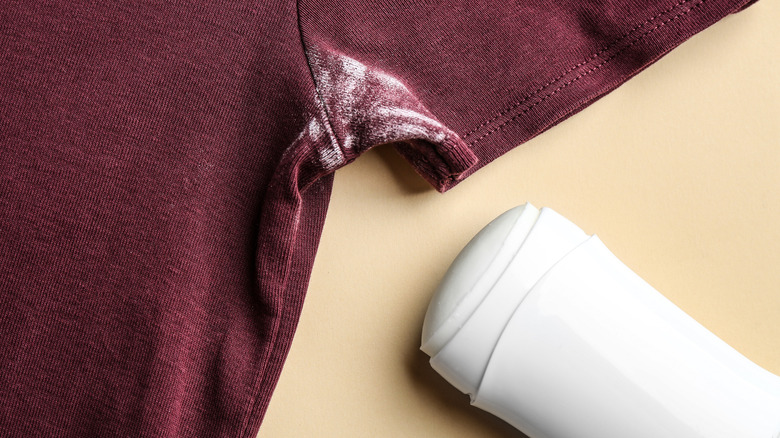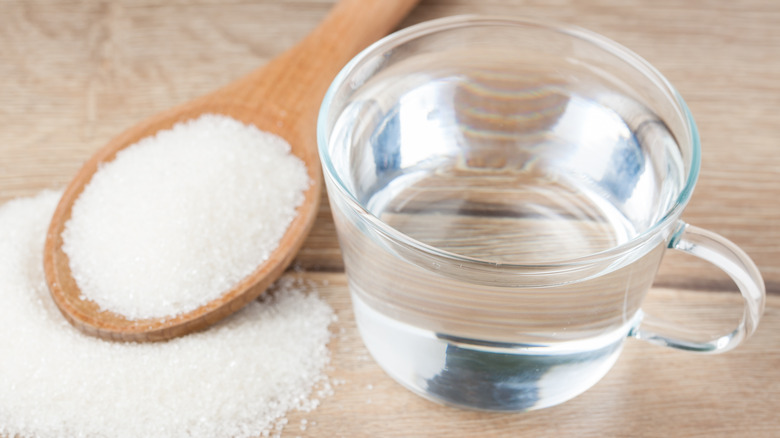Getting Deodorant Stains Out Of Your Clothes Is Easier Than Ever
You've resigned yourself to the facts. You've even cleared room on the floor of your bedroom closet. Now, all you have to do is a final check, tossing the clothes with the deepest, crustiest stains into a pile on the floor. They say that parting is such sweet sorrow. This parting is also going to cost you a chunk of money in terms of replacement costs.
But don't toss your favorite university sweatshirt into that throwaway pile just yet. Whether or not you remember anything about the periodic table of chemical elements, you can use some common household products to create some minor chemical reactions that will remove those deodorant stains. It's understandable that you're skeptical. Those chalky marks look positively etched into the underarms of your clothes — a likely mix of alkali, aluminum, and protein (via Ban). And if you use a fragrant deodorant or apply it with gusto, the marks may look especially formidable.
All this means is that you may have to make repeated cleansing attempts with the same product or revert to trying another method if a stain fades but still lingers. Clothing made of cotton or a cotton-polyester blend can withstand a little scrubbing action, while stained delicates should be left to a professional cleaner. You may even think of yourself as a professional by the time you're finished with this restorative exercise.
Try mixing a paste in your haste
Some of these stain removal methods may be familiar to you. Mixing baking soda and water, for example, makes a paste that can be applied to dozens of stains, from those on plastic food containers to mildew in shower stalls (via Good Housekeeping). What you may not know is that it works on deodorant stains, too, especially when the paste is worked into the stain with some scrubbing action (via Arm & Hammer). A soft, old toothbrush is ideal for this task.
To increase your odds of success lifting the stain the first time, let the paste sit on the stain for several hours before washing the clothing. To give the paste a boost of encouragement, dab or spray some distilled white vinegar on the area before washing the clothing in hot water (via Public Goods).
If you're short on baking soda but fully stocked with aspirin, you can mimic these moves, right down to the rubbing action with the old toothbrush. This method is best for white shirts since aspirin can fade colors. (To be certain, test it first on an inconspicuous area of the clothing.) Make a paste from about four aspirin tablets and a little water. Work in the mixture with the old toothbrush and, hopefully, watch the stain disappear before your eyes.
Lemons and hydrogen peroxide work, too
You may enjoy creating a paste, or you may prefer a quicker removal method. After all, with a pile of clothing to get through, time may be of the essence. If so, reach again for the white vinegar — a powerhouse household cleaner if there ever was one. In fact, Reader's Digest counts 96 ways it can be used around the house, and removing stains is just one of them.
In the laundry, adding one-half cup of white vinegar to the detergent department can loosen buildup and chemicals and also eliminate odors, like smoke (via Healthline). Your clothes won't smell like vinegar, either! The rinse cycle takes care of that. The smell of lemons may be more appealing. If so, squeeze some lemon juice or the juice from a fresh lemon onto the stain. The acidity of lemons makes this an effective stain remover. If you want to give it a jolt of lift power, sprinkle some salt on the area, too, before you wash your clothing.
If the deodorant stain is particularly stubborn, try mixing about 6 tablespoons of hydrogen peroxide with about 3 tablespoons of dish soap and dipping your trusty scrubbing toothbrush into the mixture and then onto the stain (via Public Goods). This mixture is known to remove red wine and vegetable oil — some of the most dreaded stains of all. Deodorant stains should fade within minutes of repetitive scrubbing motion. Then, your clothes will be like new again.


